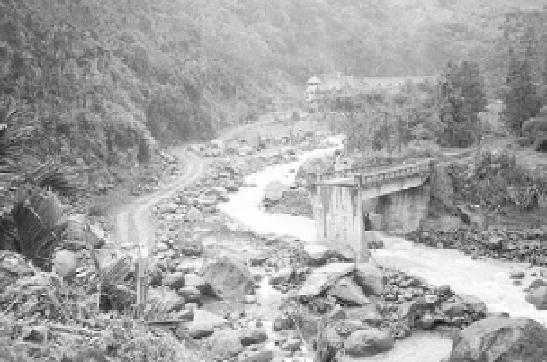Environmental Engineering Reference
In-Depth Information
On July 7, 1959, and August 5, 1979, rainstorms initiated debris flows in the Bayan and Samalong
canyons by the Qinghai-Tibet Railway. Debris flows destroyed several bridges, blocked several culverts,
damaged several hundred meters of railway tracks, buried 27 houses, overturned a freight train, and killed
17 people in 1979. The railway was cut off for two days. On July 20, 1964, a mudflow was initiated by a
rainstorm in gullies of Gaolan Mountain, in the southern suburbs of Lanzhou, Gansu Province. The mudflow
damaged a small bridge and carried and unloaded 250,000 m
3
of silt, sand, and gravel to the Lanzhou
Railway Hub. Twenty-five days latter, another mudflow from the Naoding Gully buried the Chengguanying
Station (near the Lanzhou station) again. The mudflows stopped rail traffic for 34 hours.
In 1969, a debris flow from the Puwei Gully destroyed shelters of construction workers for the Chengdu-
Kunming Railway and caused 23 casualties. In the same year, a debris flow from the Shamalada Gully
killed 40 workers who were constructing the railway. In 1974, a debris flow from Erduluku Gully buried
the Aidai Railway Station and killed two people. On July 12, 1978, a rainstorm in the Baoji-Tianshui area
triggered landslides in the Caizi Gully (with a catchment area 0.4 km
2
) and the Mitang Gully (0.5 km
2
).
The landslides soon transformed into mud flows and rushed to the Lanzhou-Lianyungang railway. The
mud flows damaged a bridge, blocked a 2.25 m arch culvert, destroyed 80 houses, and buried the Railway
with 200,000 m
3
of sediment. The debris on the railway was 4 m high and 360 hours were spent to remove it.
On July 9, 1981, a debris flow with an 8 m high head flowed from a gully to the Chengdu-Kunming
railway at velocity of 13.2 m/s. It carried rocks with diameters of several meters and the density of the
mixture was estimated at 2.32 t/m
3
. The debris flow damaged the 110 m long Liziyida Bridge at the Dadu
River of the Chengdu-Kunming Line. A pier and an abutment were destroyed. The No. 422 passenger
train crashed and overturned and 300 passengers were killed. More than 5 million dollars were lost and
the railway was blocked for 384 hours. On August 21, 1981, a long duration rainstorm initiated torrential
floods and 45 debris flows carrying huge amounts of sediment in the Baoji-Luoyang area. The debris
flows buried 5 railway stations and sections of railway tracks, damaged 8 bridges, silted 4 tunnels, and
blocked several culverts along the Baoji-Luoyang Railway line. The rail traffic was stopped for 2 months.
In Taiwan, debris flows cause cutoff of highways quite often. Figure 4.18 shows a highway bridge destroyed
by a debris flow in Hualian County in Taiwan Province, China (Zhang, 2006). Debris flows often have
cut off railway transportation. Recently a debris flow buried the mountain railway and blocked a train on
June 11, 2006 (China Times, June 11, 2006).
Fig. 4.18
A debris flow destroyed a highway bridge in Hualian County in Taiwan Province, China (after Zhang, 2006)
There are 341 debris flow gullies along the Sichuan-Tibet Highway. More than 1,300 debris flows
blocked, buried, and destroyed the highway in the past 30 years. Debris flows destroyed 17 of the 48 bridges


Search WWH ::

Custom Search